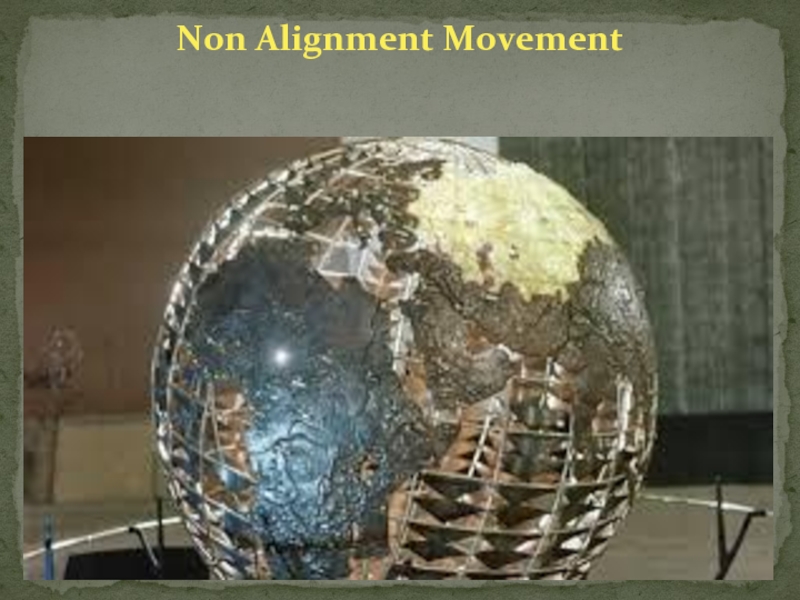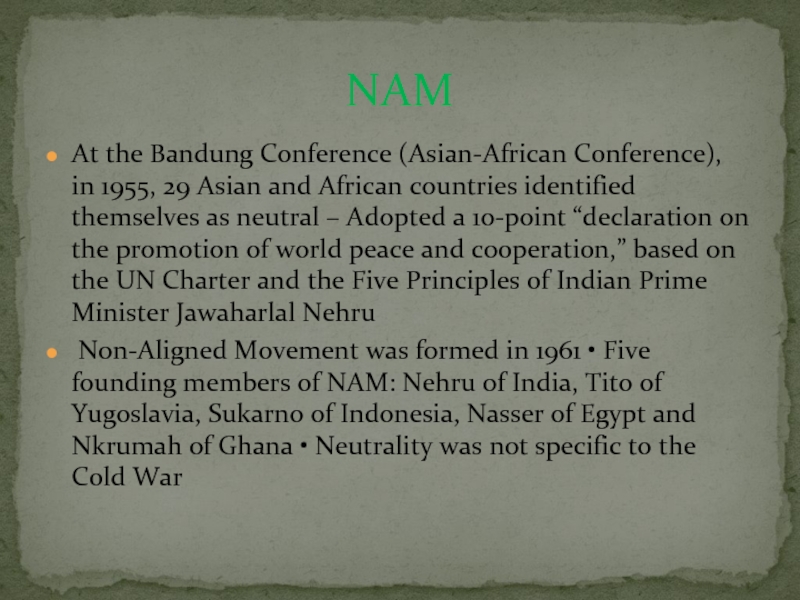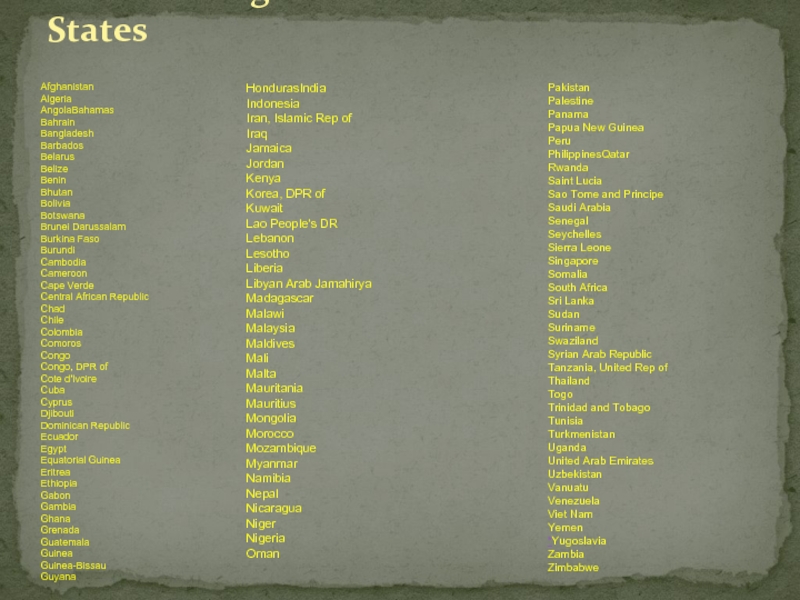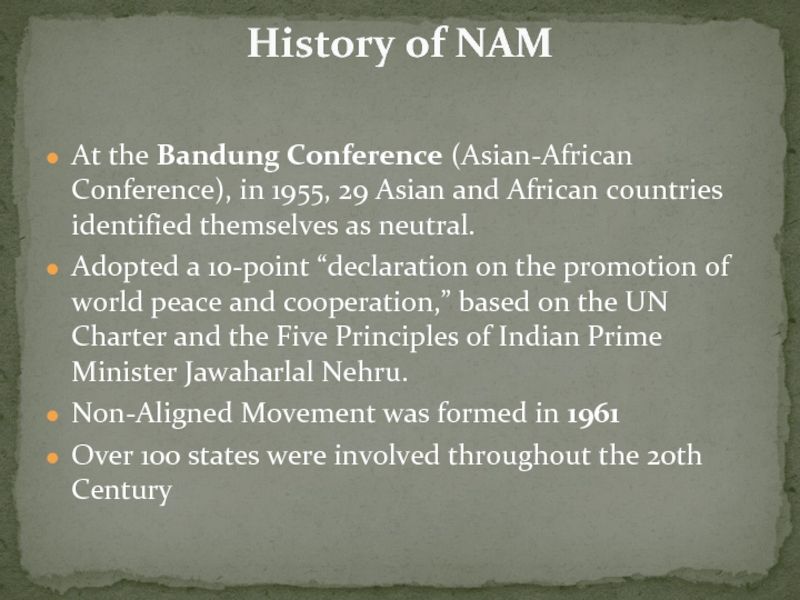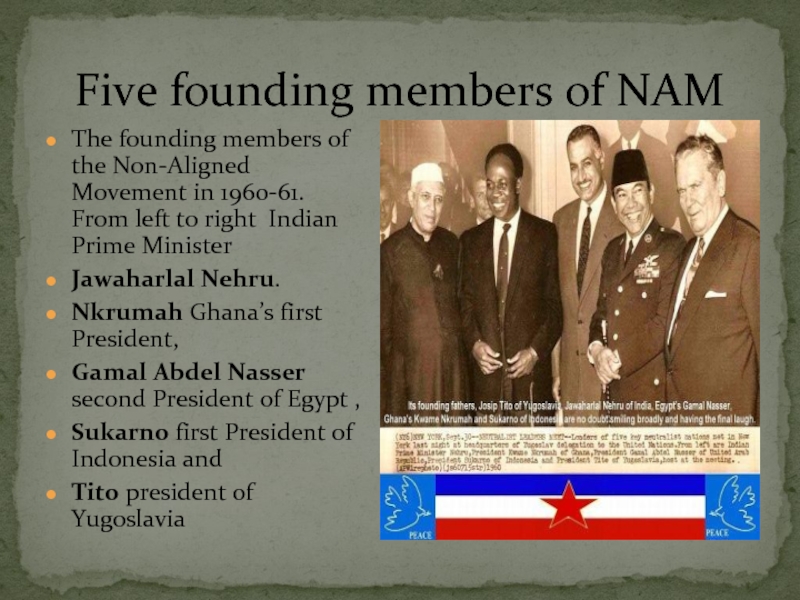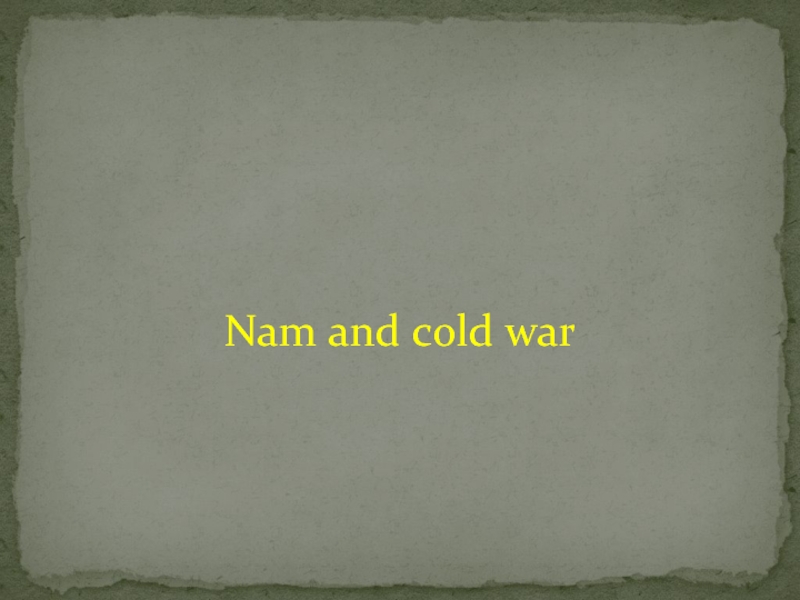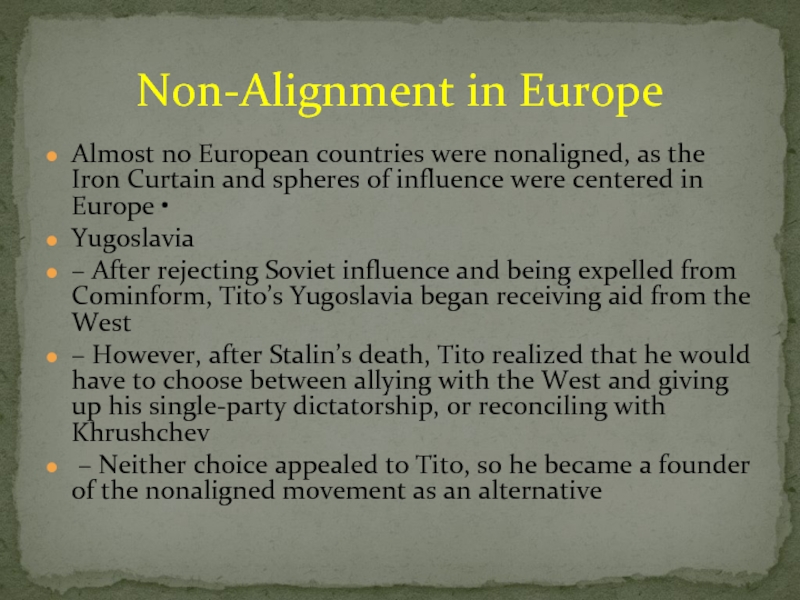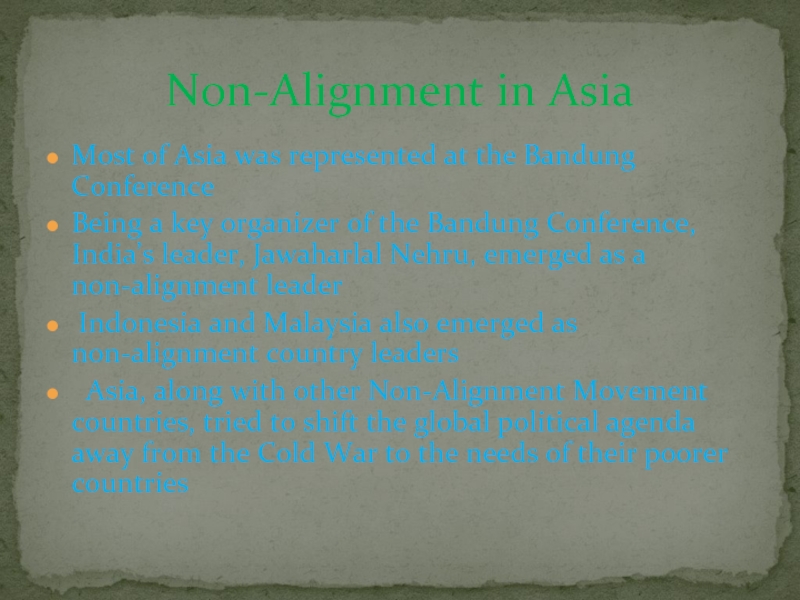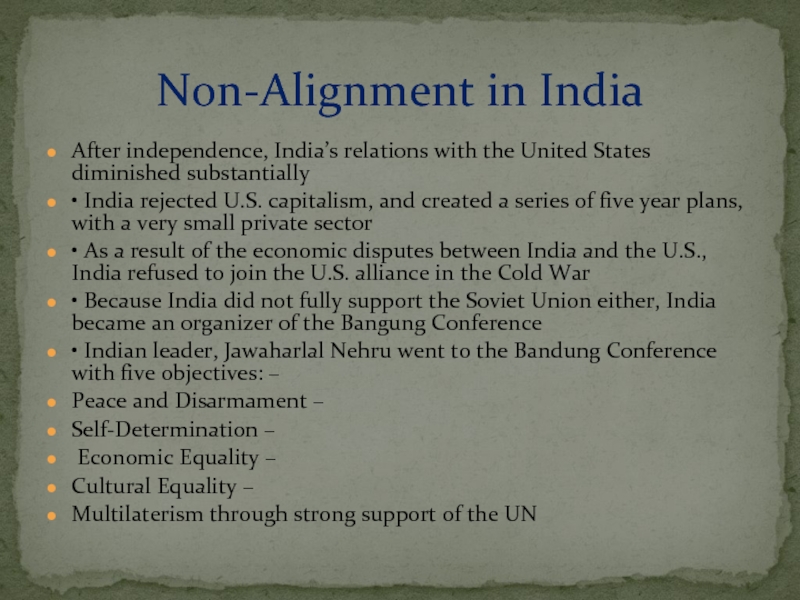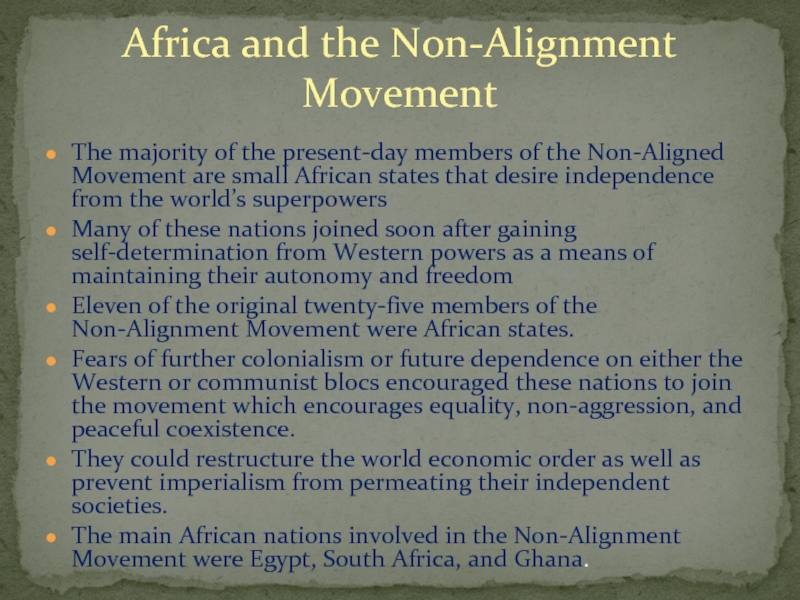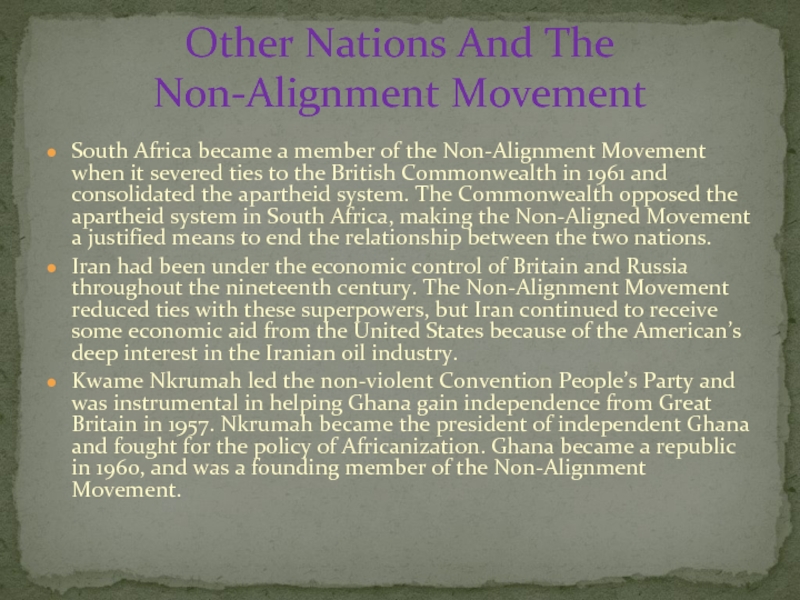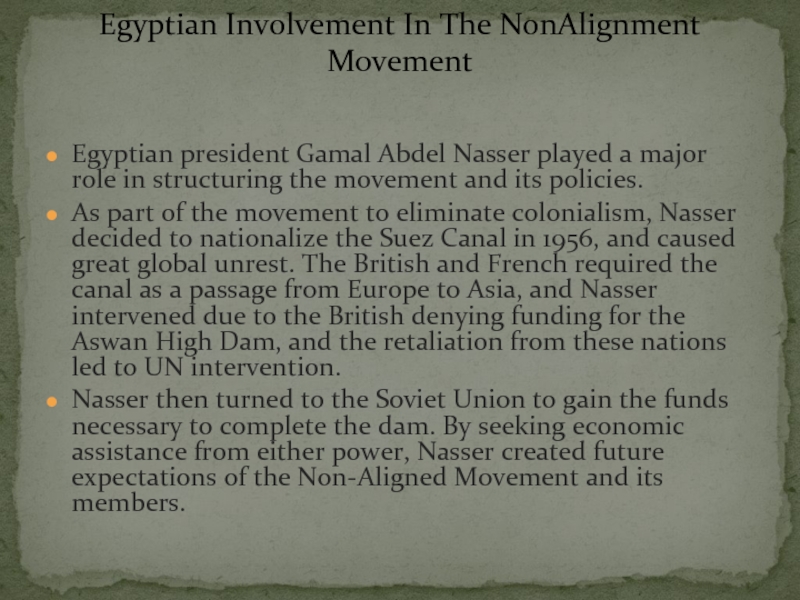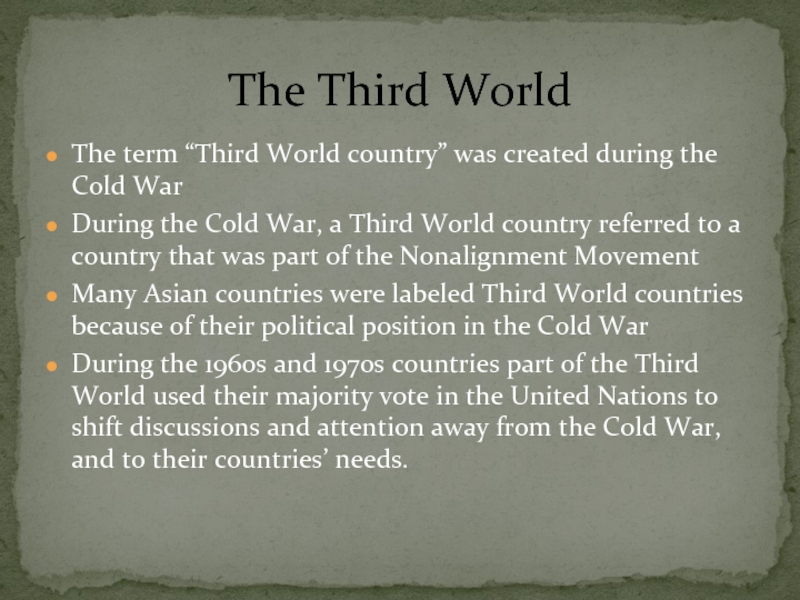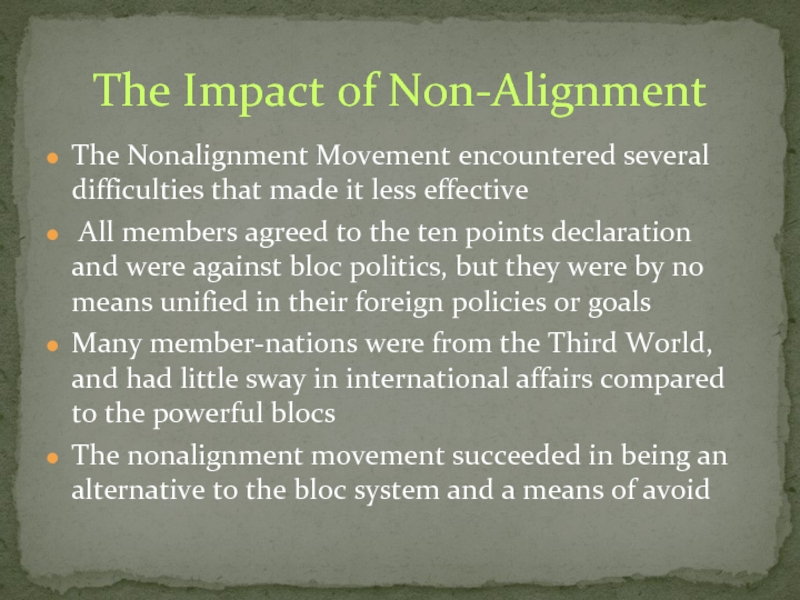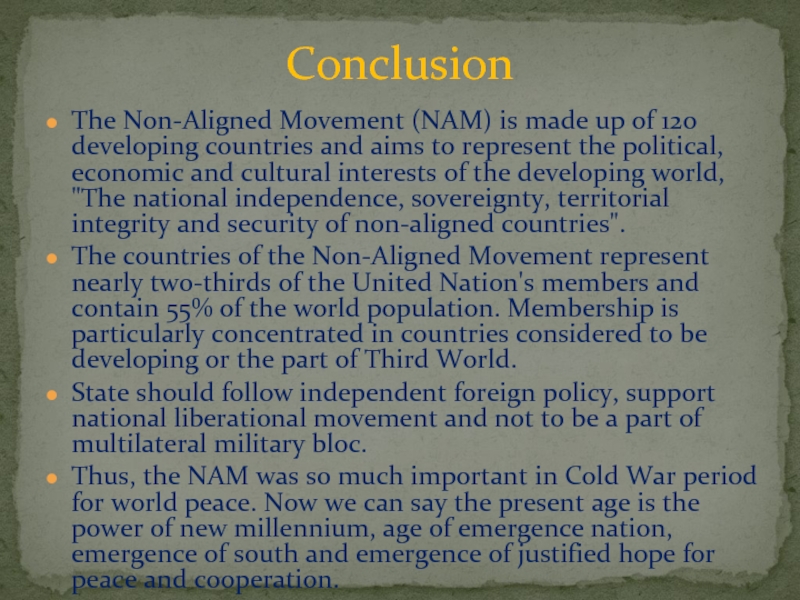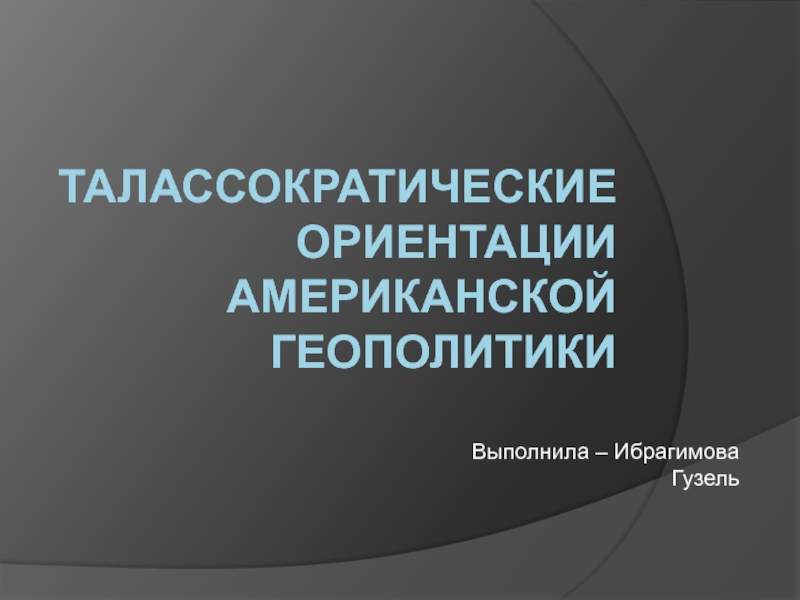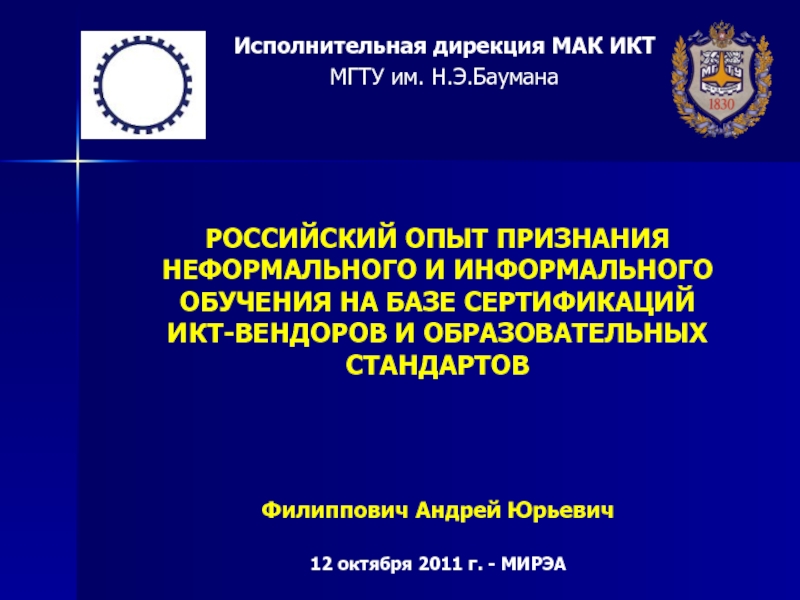- Главная
- Разное
- Дизайн
- Бизнес и предпринимательство
- Аналитика
- Образование
- Развлечения
- Красота и здоровье
- Финансы
- Государство
- Путешествия
- Спорт
- Недвижимость
- Армия
- Графика
- Культурология
- Еда и кулинария
- Лингвистика
- Английский язык
- Астрономия
- Алгебра
- Биология
- География
- Детские презентации
- Информатика
- История
- Литература
- Маркетинг
- Математика
- Медицина
- Менеджмент
- Музыка
- МХК
- Немецкий язык
- ОБЖ
- Обществознание
- Окружающий мир
- Педагогика
- Русский язык
- Технология
- Физика
- Философия
- Химия
- Шаблоны, картинки для презентаций
- Экология
- Экономика
- Юриспруденция
Non Alignment Movement презентация
Содержание
- 1. Non Alignment Movement
- 2. At the Bandung Conference (Asian-African Conference), in
- 3. The Non-Aligned Movement: Member States
- 4. At the Bandung Conference (Asian-African Conference), in
- 5. Five founding members of NAM The founding
- 6. Nam and cold war
- 7. Non-Alignment in Europe Almost no European
- 8. Non-Alignment in Asia Most of Asia was
- 9. Non-Alignment in India After independence, India’s relations
- 10. The majority of the present-day members of
- 11. South Africa became a member of the
- 12. Egyptian president Gamal Abdel Nasser played a
- 13. The Third World The term “Third World
- 14. The Impact of Non-Alignment The Nonalignment
- 15. Conclusion The Non-Aligned Movement (NAM) is
- 16. Sayed Mobashir “Khalili”
Слайд 2At the Bandung Conference (Asian-African Conference), in 1955, 29 Asian and
Non-Aligned Movement was formed in 1961 • Five founding members of NAM: Nehru of India, Tito of Yugoslavia, Sukarno of Indonesia, Nasser of Egypt and Nkrumah of Ghana • Neutrality was not specific to the Cold War
NAM
Слайд 4At the Bandung Conference (Asian-African Conference), in 1955, 29 Asian and
Adopted a 10-point “declaration on the promotion of world peace and cooperation,” based on the UN Charter and the Five Principles of Indian Prime Minister Jawaharlal Nehru.
Non-Aligned Movement was formed in 1961
Over 100 states were involved throughout the 20th Century
History of NAM
Слайд 5Five founding members of NAM
The founding members of the Non-Aligned Movement
Jawaharlal Nehru.
Nkrumah Ghana’s first President,
Gamal Abdel Nasser second President of Egypt ,
Sukarno first President of Indonesia and
Tito president of Yugoslavia
Слайд 7Non-Alignment in Europe
Almost no European countries were nonaligned, as the
Yugoslavia
– After rejecting Soviet influence and being expelled from Cominform, Tito’s Yugoslavia began receiving aid from the West
– However, after Stalin’s death, Tito realized that he would have to choose between allying with the West and giving up his single-party dictatorship, or reconciling with Khrushchev
– Neither choice appealed to Tito, so he became a founder of the nonaligned movement as an alternative
Слайд 8Non-Alignment in Asia
Most of Asia was represented at the Bandung Conference
Being a key organizer of the Bandung Conference, India’s leader, Jawaharlal Nehru, emerged as a non-alignment leader
Indonesia and Malaysia also emerged as non-alignment country leaders
Asia, along with other Non-Alignment Movement countries, tried to shift the global political agenda away from the Cold War to the needs of their poorer countries
Слайд 9Non-Alignment in India
After independence, India’s relations with the United States diminished
• India rejected U.S. capitalism, and created a series of five year plans, with a very small private sector
• As a result of the economic disputes between India and the U.S., India refused to join the U.S. alliance in the Cold War
• Because India did not fully support the Soviet Union either, India became an organizer of the Bangung Conference
• Indian leader, Jawaharlal Nehru went to the Bandung Conference with five objectives: –
Peace and Disarmament –
Self-Determination –
Economic Equality –
Cultural Equality –
Multilaterism through strong support of the UN
Слайд 10The majority of the present-day members of the Non-Aligned Movement are
Many of these nations joined soon after gaining self-determination from Western powers as a means of maintaining their autonomy and freedom
Eleven of the original twenty-five members of the Non-Alignment Movement were African states.
Fears of further colonialism or future dependence on either the Western or communist blocs encouraged these nations to join the movement which encourages equality, non-aggression, and peaceful coexistence.
They could restructure the world economic order as well as prevent imperialism from permeating their independent societies.
The main African nations involved in the Non-Alignment Movement were Egypt, South Africa, and Ghana.
Africa and the Non-Alignment Movement
Слайд 11South Africa became a member of the Non-Alignment Movement when it
Iran had been under the economic control of Britain and Russia throughout the nineteenth century. The Non-Alignment Movement reduced ties with these superpowers, but Iran continued to receive some economic aid from the United States because of the American’s deep interest in the Iranian oil industry.
Kwame Nkrumah led the non-violent Convention People’s Party and was instrumental in helping Ghana gain independence from Great Britain in 1957. Nkrumah became the president of independent Ghana and fought for the policy of Africanization. Ghana became a republic in 1960, and was a founding member of the Non-Alignment Movement.
Other Nations And The Non-Alignment Movement
Слайд 12Egyptian president Gamal Abdel Nasser played a major role in structuring
As part of the movement to eliminate colonialism, Nasser decided to nationalize the Suez Canal in 1956, and caused great global unrest. The British and French required the canal as a passage from Europe to Asia, and Nasser intervened due to the British denying funding for the Aswan High Dam, and the retaliation from these nations led to UN intervention.
Nasser then turned to the Soviet Union to gain the funds necessary to complete the dam. By seeking economic assistance from either power, Nasser created future expectations of the Non-Aligned Movement and its members.
Egyptian Involvement In The NonAlignment Movement
Слайд 13The Third World
The term “Third World country” was created during the
During the Cold War, a Third World country referred to a country that was part of the Nonalignment Movement
Many Asian countries were labeled Third World countries because of their political position in the Cold War
During the 1960s and 1970s countries part of the Third World used their majority vote in the United Nations to shift discussions and attention away from the Cold War, and to their countries’ needs.
Слайд 14The Impact of Non-Alignment
The Nonalignment Movement encountered several difficulties that
All members agreed to the ten points declaration and were against bloc politics, but they were by no means unified in their foreign policies or goals
Many member-nations were from the Third World, and had little sway in international affairs compared to the powerful blocs
The nonalignment movement succeeded in being an alternative to the bloc system and a means of avoid
Слайд 15Conclusion
The Non-Aligned Movement (NAM) is made up of 120 developing
The countries of the Non-Aligned Movement represent nearly two-thirds of the United Nation's members and contain 55% of the world population. Membership is particularly concentrated in countries considered to be developing or the part of Third World.
State should follow independent foreign policy, support national liberational movement and not to be a part of multilateral military bloc.
Thus, the NAM was so much important in Cold War period for world peace. Now we can say the present age is the power of new millennium, age of emergence nation, emergence of south and emergence of justified hope for peace and cooperation.
